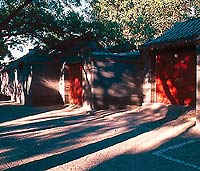 Experts devoted to protecting old houses in Beijing are holding a photo exhibition to widen awareness of the necessity of preserving traditions and relics.
Experts devoted to protecting old houses in Beijing are holding a photo exhibition to widen awareness of the necessity of preserving traditions and relics.
The photo exhibition, titled "Retain Courtyards - the Soul of Beijing," will run until Thursday at the Beijing Working People's Palace of Culture, located to the east of the Forbidden City.
"Bulldozers should stop demolishing old houses during the traditional holiday, and we should utilize the chance to arouse people's awareness to protect our traditions and relics," said Hua Xinmin, a French writer who was brought up in Beijing's historic hutong - traditional alleyways.
The writer said it was essential that people's awareness of the need to preserve traditional buildings was widened during Spring Festival.
A total of 112 traditional courtyards located in central Beijing are represented at the exhibition, displaying different architectural styles of Beijing's residential buildings.
Most of these old houses are set to be demolished during urban renovation in the city because they are outside the protection zones established by municipal leaders.
According to Beijing's historical street protection plan which was released last year, about 40 historical and cultural sections have been selected for special protection.
Of these, 30 are in the ancient city area. In addition to 200 heritage sites, they cover a total area of 2,617 hectares in the old city, meaning 42 percent of the old city is to be preserved.
But experts argue the protected areas include famous heritage sites such as the Forbidden City and too few residential buildings are slated for protection.
Experts estimate 3,000 hutong remain in Beijing, but about 500 hutong disappear each year.
Beijing's courtyards - first built in the Yuan Dynasty (1271-1368) when the city was taken as the national capital - are the epitome of China's traditional urban residential buildings.
"Their design, layout and materials reflect the ancient philosophy of harmony between humans and heaven," said Zheng Xiaoxie, an 80-year-old architect and senior consultant to the Ministry of Construction.
Xu Pingfang, president of China Association of Archaeology, said the situation in China contrasted with that in Paris or London where urban buildings have been developed spontaneously. Most ancient Chinese cities have clear urban planning drafts at the beginning of urban construction.
"Therefore, if we want to preserve our traditional architectural culture, we must conserve historical communities as a whole instead of only protecting some important buildings," Xu said.
The exhibition is jointly sponsored by the United Nations Educational, Scientific and Cultural Organization and the Humanities Environment Protection Committee under China Society for Strategy and Management.
(China Daily February 8, 2003)
|

